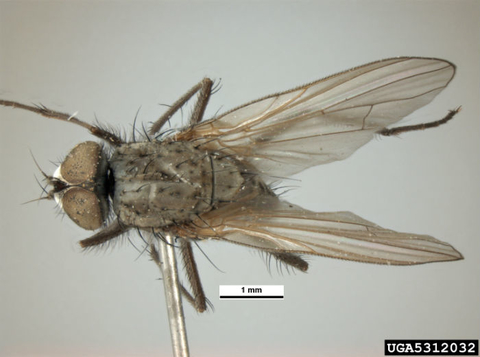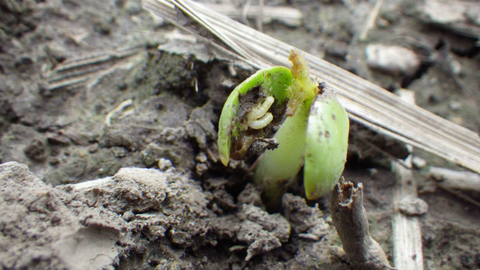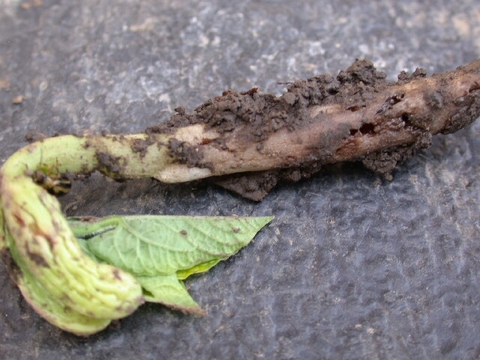Identification of seedcorn maggot (Delia platura)
Adults (Figure 1)
- Fly has a grayish–brown body and is about 1/5-inch long, with wings that overlap when at rest.
- Often mistaken for a small housefly.
Eggs
Eggs are elongated and white and not usually seen.
Larvae
Larvae are white–colored with a brown head, and less than 1/4-inch long.
Pupae
Pupae are brown, cylindrically shaped, and less than 1/4-inch long.
Natural history
Seedcorn maggot overwinters as a pupa in the soil. In the early spring, adult flies emerge and mate. Female flies lay eggs within cracks in the soil, or under soil clods.
Disturbed soil with decaying organic matter, such as manure or green plant material (cover crop or weeds), is highly attractive to female flies for egg laying. Eggs can hatch within two to four days and maggots move to and feed on seed and germinating plants (Figure 2). Fully developed larvae pupate in the soil, about three to six inches deep, and emerge as flies 12 to 14 days later. There are four to five generations per year.
Impacts
Seedcorn maggot feeding can result in direct loss by destroying the seed and causing stand loss.
Maggots will also feed on developing cotyledons, which can destroy the growing tips, resulting in "snakehead" plants. These then may die or become "Y–plants," where branching develops at surviving nodes.
Yield from "Y–plants" may be reduced if competing with neighboring healthy plants.
Feeding by seedcorn maggot can also lead to secondary infection by fungi and can cause damping off (Figure 3).
Management
Thee are no rescue treatments for seedcorn maggot. Once seedcorn maggot injury is noticed, it is too late to use any control methods. All management decisions need to be made prior to planting and should be based on the risk of economic infestation.
Risk for economic infestation by seedcorn maggot is greater in:
- Fields with a history of infestation by this pest.
- Fields with fresh organic matter, such as animal manure or green plant material (cover crops, weeds, etc.), that has been recently incorporated into soil.
- Cool, wet soils that delay emergence and increase time that the seed and emerging plants are susceptible to attack by soil pests.
Cultural control
- Delay planting until soil temperatures promote rapid seed germination.
- Avoid planting at least two weeks after fresh organic materials are incorporated into soil.
- Degree–day models can guide decisions about adjusting planting date to avoid periods with high larval abundance. Seedcorn maggot development is estimated using a base temperature of 39°F (3.9°C) for degree–day calculation.
- Planting should be avoided during peak fly emergence, which occurs for the first three generations when 354, 1080, and 1800 degree–days have accumulated, respectively.
- To calculate degree days for your area, visit the UW Extension degree day site.
Chemical control
Rescue treatments are not available for this pest. Preventative use of seed–applied or in–furrow insecticides may be considered for fields with high risk for economic infestation by seedcorn maggot (see above for risk factors). Follow instructions on insecticide label.
Estimation of stand loss and replant decisions
Fields should be inspected for stand loss during seedling growth stages. Soybean is a resilient crop, able to tolerate relatively high levels of stand loss. However, when significant stand loss occurs, replanting may be required, but this option should be considered carefully. Information is available on how to estimate plant stand and guide replant decisions in soybean (U of M Extension soybean replant guide). This emphasizes the importance of knowing the field history, previous infestations, and current degree days.
Reviewed in 2015




